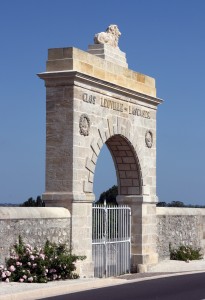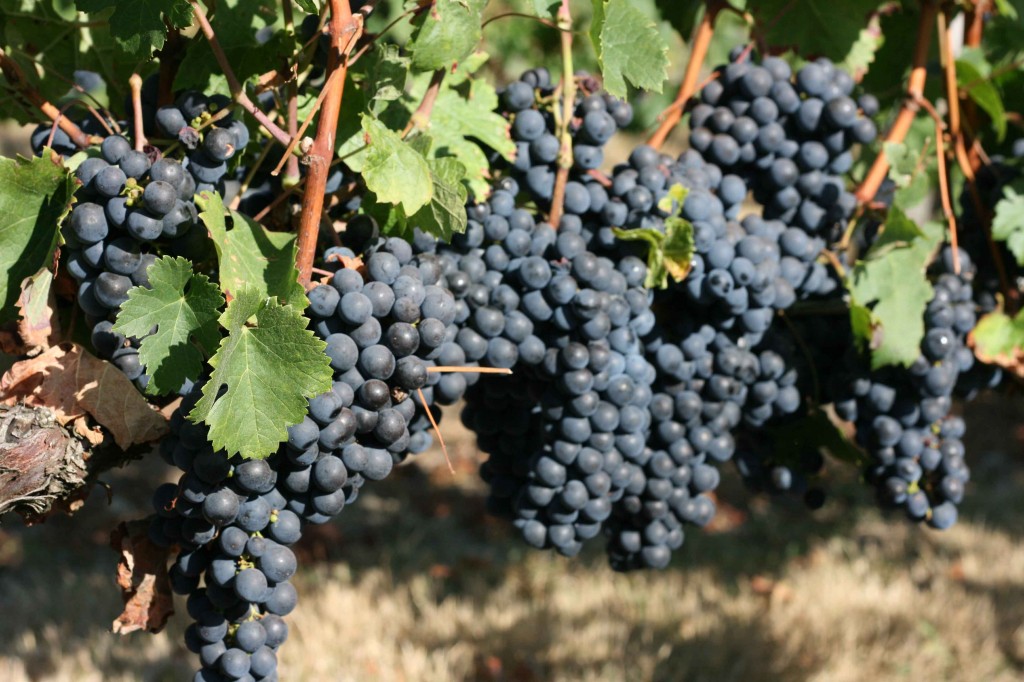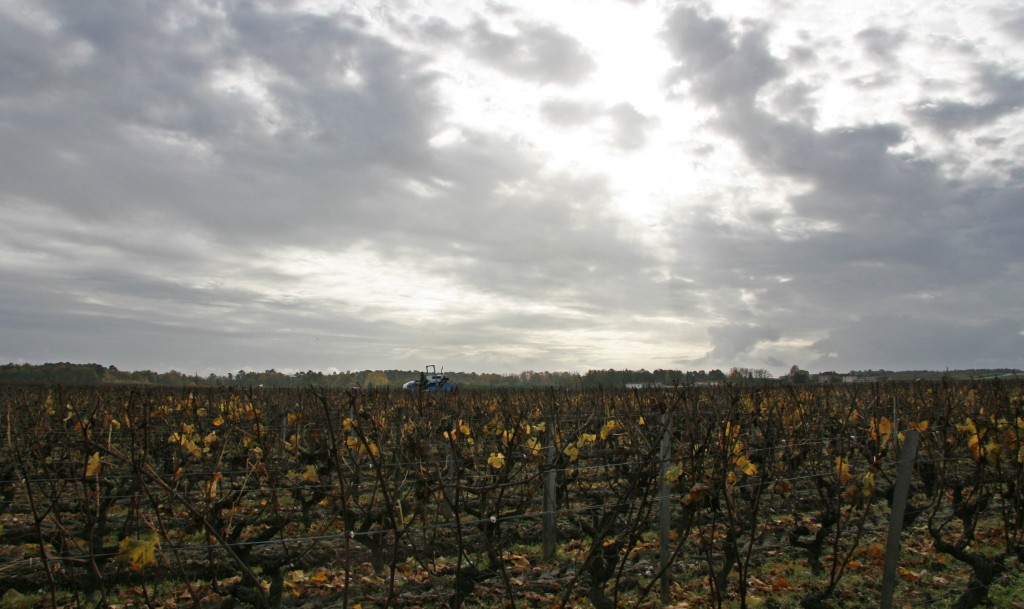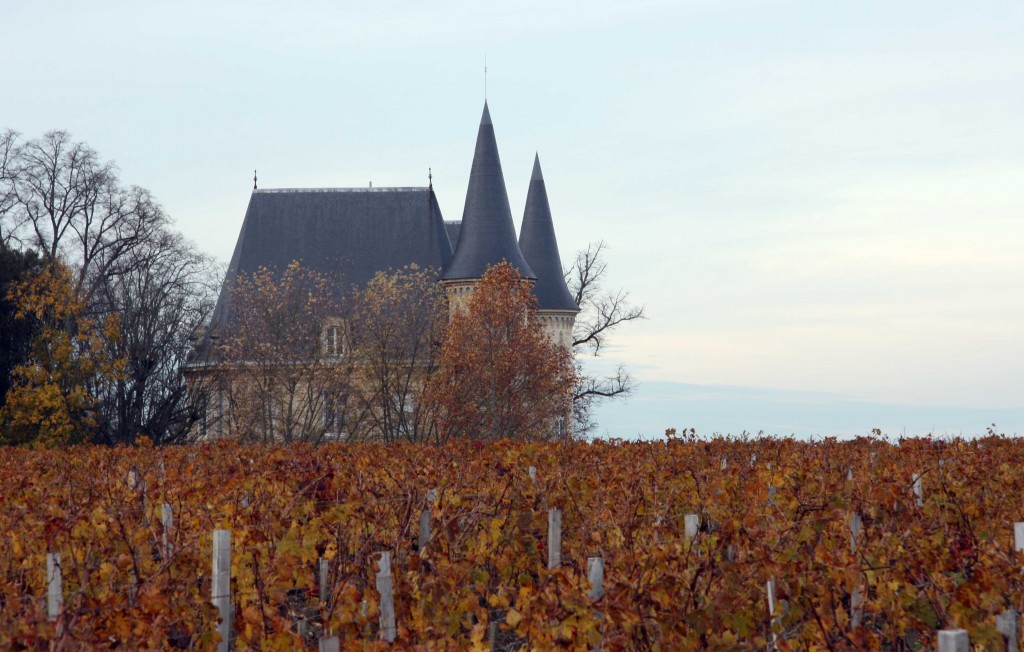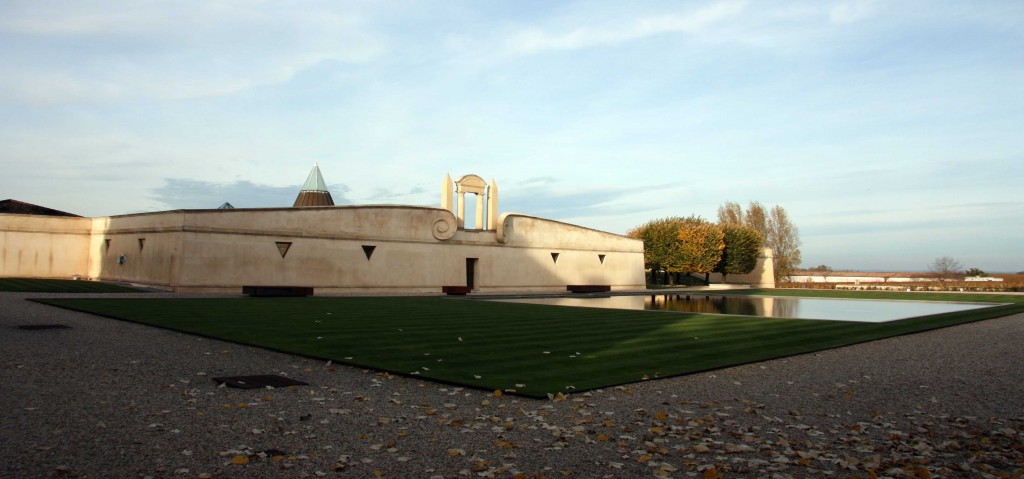Here are my notes from the annual Institute of Masters of Wine tasting, held in London on Wednesday 5 November – an utterly appropriate date to appreciate some vinous fireworks.
I’ve never tasted a vintage quite like it, not even 2005 and on this evidence of this tasting, the wines are every bit as good as their reputation, even if as it always bound to be the case, one or two fall short in one way or another.
The weather in 2010 was remarkably favourable, even allowing for a late budding and a difficult flowering. Indeed, the reduction in yields brought about by the latter only served to concentrate the remaining crop.
Rainfall was low, but a burst of heavy rain on 7 and 8 Sepetmber came to the rescue and enabled the grapes to achieve a remarkable level of ripeness. As Florence de la Filolie of Château Laniote (Saint Emilion Grand Cru Classé) remarked, “The very high sugar levels did, however, give us cause for concern: very small, sugar-gorged berries, with very thick skins rich in polyphenols. Despite the high potential alcohol, we had to wait a while to secure the full phenolic ripeness of the skins and pips.” This duly came in early October after weeks of perfect conditions: warm days and cool night that mean that the 2010s are both more aromatic and have fresher acidity than the 2009s. Florence reported that, “the fermentations started without any further worries, despite the high sugars. The polyphenols in the skins were easy to extract.” She then adds, “Because of the high level of alcohol we had to manage the process of vinification with great care to ensure against any over-extraction of the tannins.” Other winemakers were less careful, especially in Saint Emilion and Pomerol, as my notes show.
That said, the dominant characteristics of 2010 are balance allied with power and often an extraordinary depth of fruit. The different appellations are clearly defined. Margaux is exceptionally good, with the perfume of many wines, for once, completely in line with the reputation of the appellation. One small surprise at this tasting is the relative softness of the acidity of some wins from Saint Estèphe in comparison to the Pauillacs.
I’m cautious with making comparisons with past vintages, but I can’t help being reminded of the similarities that the red wines have with the much-fabled 1961, though 2010 is a bigger crop, alcohols are much higher, and by and large, blessed of course, with much better winemaking. The sweet wines are also very good indeed.
Pessac-Léognan/Graves
Château de Fieuzal
Intense with lots of savoury black fruit and scented with a whiff of iodine.
Fresh acidity, firm, ripe tannins, balanced and quite long – very savoury.
Château Haut-Bailly
Very perfumed and complex – fine, classic, cedary aromas.
Fresh acidity, very silky but persistent tannins. Long with a savoury finish.
Château Haut-Brion
Rich and complex, but just a little closed.
Lots of concentrated, creamy black fruit. Fine balance of acidity and tannin. Great elegance, despite at least 15% abv. Very long.
Château La Mission Haut-Brion
Big, rich and scented, quite complex.
Fresh acidity balanced by rather firm tannins. Complex flavour of almost herby black fruit. Long.
Château Smith Haut Lafitte
Very fragrant.
Juicy acidity and ripe, silky tannins – lovely balance. Quite concentrated, but marked more by elegance and length.
Domaine de Chevalier
Quite a powerful aroma – very savoury.
Fruitier on the palate with a good balance of fresh acidity and silky tannins. Long, with new oak showing at the end.
Haut-Médoc
Château Cantemerle
Rather green and stalky in the context of the vintage.
Sweeter and riper in the mouth than the nose suggests, with fresh acidity and slightly dry tannins, but quite elegant and also quite long.
Château La Lagune
Rather closed, but good concentration.
Balanced acidity and tannins. Attractive in a rather chunky way, but lacks complexity.
Margaux
Château Boyd-Cantenac
Very perfumed, cedary and almost spicy.
Sweetly ripe with balanced acidity and tannins. Already open, not overly concentrated, but quite long.
Château Brane Cantenac
Beautifully perfumed, with concentrated, elegant black fruit.
Refreshing acidity balanced by firm but silky tannins. Sweetly ripe, long and very elegant. Lovely wine.
Château Cantenac Brown
Very deeply coloured. Concentrated perfumed black fruits.
Very fresh acidity and firm tannins. Lovely juicy black fruit. Long and elegant with new oak showing.
Château Durfort-Vivens
Relatively simple, fruity nose.
Balanced acidity and tannin. Relatively light, but quite long with a very savoury finish.
Château Giscours
Elegant, rather perfumed black fruit. Quite concentrated.
Fresh acidity and firm tannins – finely balanced with a creamy texture. Long oaky finish.
Château Lascombes
Very scented, even perfumed.
Balanced with fresh acidy and firm tannins. Quite long.
Château Margaux
Intensely aromatic matched by extraordinary complexity.
Fresh acidity balanced by wonderfully silky tannins. Very perfumed in the mouth; elegant, intense and very long – a stunningly good wine.
Château Palmer
Scented, very elegant, with cassis aromas.
Extremely elegant in the mouth, balanced, complex and long.
Château Rauzan-Gassies
Quite complex, perfumed, but a little raisiny.
Fresh acidity, but not quite as tannic as many and also relatively light. Reasonable complexity and length.
Château Rauzan-Ségla
Intensely perfumed and spicy.
Balanced with fresh acidity and firm tannins. Good concentration. Very elegant and long.
Saint Estèphe
Château Calon-Ségur
Big and powerful, though just a little stalky.
Balanced with juicy acidity and firm tannins. Quite long and concentrated.
Château Cos d’Estournel
Very deep-coloured. Powerful aromas of savoury black fruit.
Very rich, concentrated and complex. Marked more by its abundant tannins than by acidity. Very long.
Château Cos Labory
Complex, very perfumed fruit – brambles and mulberry with spice.
Very rich, intense and sweetly ripe, relatively soft acidity but firm, silky tannins. Very long. Impressive.
Château Lafon-Rochet
Black olive aromas seem almost reductive.
Very sweetly fruity. Tannin defines the structure more than acidity. Reasonable length but not too complex.
Château Montrose
Big, black and concentrated.
More tannic than acid. Very concentrated cassis and other black fruits. A bit chunky. Powerful. Quite long.
Saint Julien
Château Beychevelle
Sweetly-perfumed aromas of ripe cassis.
Fresh acidity and firm, strong tannins. Big and powerful with dark fruit and liquorice. Not, perhaps, the last word in elegance, but very long.
Château Branaire-Ducru
Quite scented, complex black fruits.
Fresh acidity, firm tannins. Black fruits and liquorice again. Powerful and long.
Château Lagrange
Classic, creamy, cedary and complex.
Balanced acidity and tannin. Sweet, quite rich, a little chunky. Long
Château Langoa-Barton
Fine, elegant and complex.
Very juicy acidity and firm tannins – big structure but well balanced, with lots of fruit. Very long.
Château Léoville-Barton
Very concentrated, intense, very ripe even raisiny.
Big and structured, with balanced acidity and tannin. Masses of sweetly-ripe fruit and very long.
At best, an excellent wine, but quite a lot of bottle variation.
Château Léoville-Las Cases
Lovely purity of intense cassis fruit.
The purity continues onto palate. Elegant balance, but rather dry finish.
Château Léoville-Poyferré
Deep, rich, earthy aromas.
More tannin than acidity. A creamy texture. Quite complex and long.
Château Saint-Pierre
Very scented black fruit. Complex.
Fresh acidy and firm tannin, but with a lightness of touch, great elegance and length.
Château Talbot
A first seemed a little reductive – tight, rich concentrated cassis.
Fresh acidity, firm, silky tannins, good depth of cassis flavours, quite complex and long.
Pauillac
Château Batailley
Pure, fine, concentrated cassis
A little more tannin than acidity. Creamy. Cassis flavours. Quite long but lacks a little complexity.
Château Duhart-Millon
Slightly stalky black fruit.
More tannin than acidity. Quite complex and long.
Château Grand-Puy-Lacoste
Perfumed with tobacco and cedar – classic claret aromas.
Fine balance of acidity and silky tannins. Good length.
Château Haut-Batailley
Intense, complex, creamy, black fruit perfume.
Very juicy, pure fruit flavours, silky tannins and fine length. Incredibly attractive wine.
Château Lafite-Rothschild
Very exciting, perfumed black fruit. Great complexity.
Fresh acid and even more, finely textured tannin. Very long. Outstanding.
Château Mouton Rothschild
Deep, complex, concentrated black fruit aromas, especially of cassis.
Fresh acidity and powerful tannins. Silky texture, sweet fruit, powerful and long.
Château Pichon-Longueville
Very complex, fine, spicy black fruits, well integrated oak.
Fresh acid, firm tannins – very well-balanced. Pure, intense and very long, with new oak at the finish.
Château Pichon-Longueville Comtesse de Lalande
A little closed, but elegant and perfumed.
Balanced acidity and tannin. Beautifully ripe, juicy but elegant fruit. Long.
Château Pontet Canet
Big, ripe and complex, cassis to the fore.
Lovely balance and great purity of fruit. Very good length.
Saint-Emilion
Château Angelus
Sweet, open and brambly. Quite complex.
Soft acidity, moderate levels of tannin. Sweet, attractive, brambly fruit. Reasonably complex and long. Good wine, but not quite up to the level of the longer established first growths.
Château Beauséjour-Bécot
Tobacco and spice – very complex.
Moderate acidity and quite firm tannins. Rasperry, bramble and other dark fruits. Quite elegant and long.
Château Bélair-Monange
Big, ripe, chocolatey aromas, with spicy fruit. Complex.
Quite structured; moderate acidity and rather dry tannins. Seems rather extracted. Quite good length, with new oak showing.
Château Berliquet
Fine, fresh, red fruit aromas, with ripe brambles. Good complexity.
Quite fresh acidity with balanced, but not pronounced tannins. Very elegant and quite long. Already approachable.
Château Canon
Fine, elegant, perfumed and complex.
Quite soft acidity and moderate tannins. Rich, ripe chocolatey. Quite complex. Long and already quite open.
Château Canon La Gaffelière
Big, open, raisiny fruit. Rather extracted, with alcohol showing too.
Soft acidity, moderate tannins, rich chocolatey flavours – rather more interesting than the nose. Quite long.
Château Cheval Blanc
Very perfumed, with grassy raspberry aromas. Very complex.
Quite soft acidity but rather firm tannic structure. Slightly herby. Intense. Very long, with new oak at the finish.
Château Corbin
Perfumed new oak, with rich, brambly fruit.
Soft acid, but quite firm tannins. Quite powerful, with good complexity and length. Alcohol shows at the finish.
Château Dassault
Perfumed, with medium intensity and complexity.
A little higher acidity than tannin. Rich, chewy and chocolatey. Quite complex and long.
Château La Dominique
Intense savoury and dark chocolate aromas.
Powerful, alcoholic and with a structure based rather more on tannin than acidity. Long.
Château Figeac
Big, but fine, ripe, complex aromas with new oak showing.
Quite structured, with rather dry tannins, sweet fruit and a long finish dominated by new oak.
Château Grand Corbin
Very ripe brambly fruit – perfumed and complex.
Soft acidity, moderate tannins, ripe. Quite concentrated and long.
Château Larcis-Ducasse
Elegant, complex, perfumed aroma of brambles and tobacco.
Sweetly ripe, neither very acidic nor tannic, but rich, easy and perfumed in the mouth, with brambly fruit and good length.
Château Pavie Macquin
Dark, creamy and concentrated, with chocolatey aromas and alcohol.
Quite firm tannins. Big, rather extracted flavours, but good length.
Château La Tour Figeac
Perfumed and quite intense.
Moderate levels of acidity and tannin. Lighter in the mouth than many, with red fruit flavours. Quite long.
Château Troplong-Mondot
Sweetly ripe aromas of chocolate, cherry and brambles. Perfumed, complex and concentrated.
Fresh acidity and moderate tannins. A lovely depth of fruit, with both concentration and length. Very fine.
Château Trottevieille
Big, raisiny, over-ripe aromas.
Acidity is quite high, but also seems a little volatile. Rather dry tannins. Lacks elegance, but quite long.
Judgement reserved.
Clos Fourtet
Perfumed – almost herby and complex with brambly fruit.
Medium acidity and a moderate level of tannins, finishing long, a little dry, but with an underlying elegance.
Pomerol
Château Beauregard
Rich, plummy chocolatey and quite complex.
Moderate acidity and quite firm tannins. Medium length and complexity. A little chunky.
Château Le Bon Pasteur
Very perfumed. Quite complex.
Balanced acidity and tannins. Surprisingly light-bodied with a long flavour of red fruits.
Château Clinet
Deep, ripe brambly aromas. Quite complex with new oak showing.
Soft acidity and miderate tannins. Very ripe, quite complex, but a little short.
Château La Conseillante
Oaky, perfumed intense and very complex with black fruit aromas.
Balanced acidity and tannin. Spicy and long.
Château La Fleur-Petrus
Deep, powerful, intense and chocolatey.
Sweetly ripe, but quite elegant, brambly fruit, with balanced acidity and tannins. Long.
Château Gazin
Aromatic and fine with complex, brambly fruit.
Medium acidity and tannin, with very ripe, but fine, brambly fruit and a long finish.
Château Nenin
Dark, complex, chocolately, black fruits.
Quite fresh acidity and quite firm tannins. Complex and long.
Château Petit Village
Very perfumed, spicy, brambly and extremely complex.
Balanced acidity and tannins, elegant and long.
Château Trotanoy
Fine, concentrated, rich and complex.
Quite soft acidity, medium tannins, rich, with bramble and mulberry flavours. Very long. Classy.
Clos René
Open, but complex, ripe red fruit aromas, especially raspberry.
Less complex in the mouth. Medium acidity and quite firm, chewy tannins. Quite long.
Domaine de L’Église
Rich, quite plummy mulberry aromas. Not overly complex.
Balanced acidity and tannins. Good concentration and length. Already quite open.
Sauternes/Barsac
Château Climens
Intense but elegant peach and apricot aromas.
Soft acidity, very sweet, creamy and long. Oak showing.
Château Coutet
Fine, elegant aromas.
Rich, sweet, elegant and long.
Château Rieussec
Elegant, but the alcohol shows a little.
Fine with quite fresh acidity, a good concentration of peach and apricot fruit and good length.
Château Suduiraut
Complex, intense, botrytised fruit.
Sweet, intense orange and apricot fruit. Good freshness, creamy and long.
Château D’Yquem
Quite pale coloured. Very intense but elegant peachy aromas. Very complex and very beautiful.
Medium acidity, extraordinary elegance, balanced sweetness and great length. Outstanding.
Clos Haut-Peyraguey
Big, ripe, marmalade and apricot aromas.
Sweet, quite soft acidity. Good level of complexity and length, though with a slightly bitter finish.
